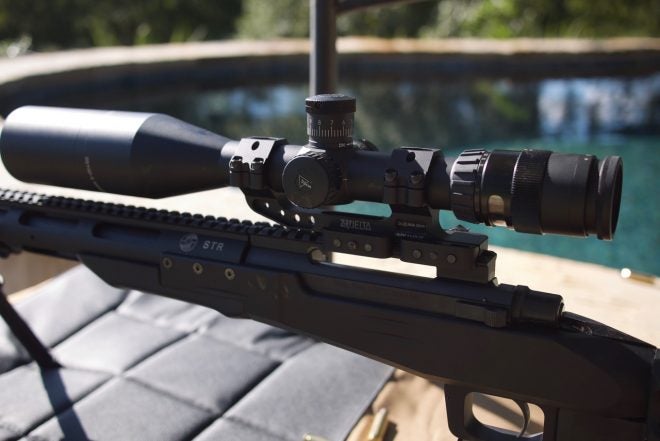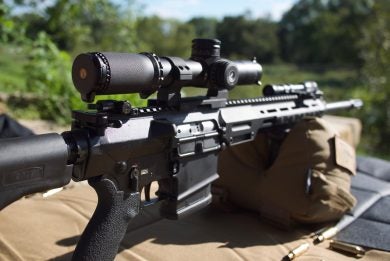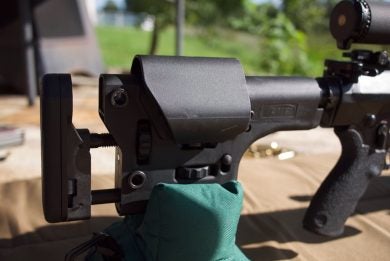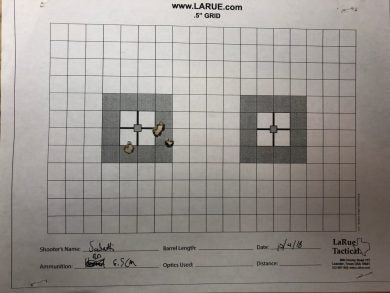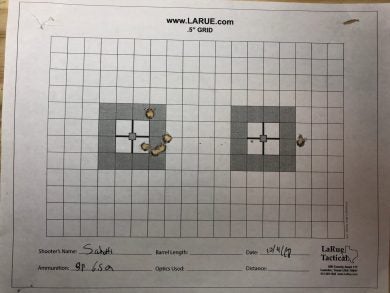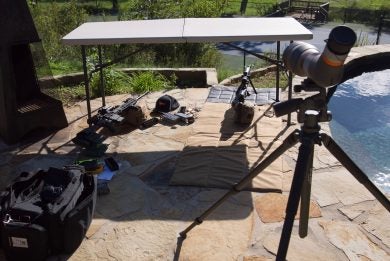A while back I took delivery of a Trijicon AccuPoint 5-20×50 for T&E, and I just recently got it mounted on a rifle and was able to take it out and start messing around with it on the range. I shot this scope alongside a completely different scope from Leupold on a completely different gun, just to maximize my range time, so I’m going to do this review in the context of a range report and that focuses on the optics.
So read on for a look at the $1399 Trijicon AccuPoint 5-20X50 with the standard duplex reticle.
Features and Specs
- Advanced fiber-optics and tritium aiming-point illumination speeds target acquisition and extends available shooting hours
- Dual-illumination system automatically adjusts aiming-point brightness to existing lighting conditions
- Manual brightness override allows shooters to easily adjust the reticle to suit their preferences
- 30mm tube offers a greater range of mounting options
- Rugged, aircraft-quality, hard-anodized aluminum body offers all-weather protection
- Unmatched long eye relief protects against the recoil of higher caliber rifles
- Easy-to-use external turret controls for windage and elevation adjustment
- Side parallax adjuster for enhanced accuracy at long range
| Magnification | 5x-20x |
| Objective Size (mm) | 50 |
| Bullet Drop Compensator | No |
| Length (in) | 13.6 w/out sunshade 16.6 w/ sunshade |
| Weight (oz) | 26.9 w/out sunshade 29.4 w/ sunshade |
| Illumination Source | Fiber Optics & Tritium |
| Reticle Pattern | Standard Duplex Crosshair |
| Day Reticle Color | Amber |
| Night Reticle Color | Amber |
| Bindon Aiming Concept | No |
| Eye Relief (in) | 3.8 to 4.1 |
| Exit Pupil (mm) | 10 to 2.5 |
| Field of View @ 100 yards (ft) | 19.1 to 5.1 |
| Adjustment @ 100 yards (clicks/in) | 1/4 (0.25) MOA per click |
| Tube Size | 30mm |
| Housing Material | 6061-T6, black hard coat anodized |
| Adjustment Range | 40 MOA Total Travel |
| Waterproof | 10ft. (3m.) |
The Gear
Apart from the fact that they’re both black in color, both chambered in the latest hipster fad caliber (6.5 Creedmoor), and would probably make the NYT editorial board have a heart attack, the two guns that I took to the range the other day are very different.
The gun that I put the AccuPoint on is the Sabatti STR chassis rifle that I shot at a long-range shooting clinic and got amazing results with. This short range session was my second time to really work with this gun since that trip, and I have some additional thoughts on it that I’ll put in the section below.
The Sabatti is a bolt-action chassis gun in 6.5 Creedmoor with a very long 26″ barrel. Despite the fact that 6.5 CM is a short action caliber, this rifle uses a long action bolt for reliability reasons. You can read my main impressions of the rifle, here, but basically, this is a great gun. I should admit that I sorta kneecapped this gun by not taking the time to bust out an Allen wrench and set it up properly to fit this new scope and mount. I just tried to make it work without really doing any ergonomic adjustments, and it turns out this was a pretty big mistake from a group size standpoint, but it did give me an important insight into one of the benefits of the AccuPoint scope. But more on that in a minute.
I put the AccuPoint 5-20X50 on a 30mm DLOC-M4 ZRODELTA mount, which I’m super duper pleased with. I got turned on to the ZRODELTA mounts by Jonathan Owen over at SHWAT.com; these are better than the LaRue QD mounts for two reasons: 1) there’s way more metal in contact with the rail on QD side, and 2) the LaRue mounts will eat a little bit of aluminum off your rail if you attach and detach them, which is not awesome, but the ZRODELTA mounts don’t do this.
It’s also the case that, like LaRue, ZRODELTA mounts are made in Texas, and things that are made in Texas are better than things that are made anywhere else. So I didn’t even have to abandon Texas in switching to these new mounts. Anyway, this mount deserves a full review of its own, but for now, it suffices to say that I’m bailing on LaRue for QD scope mounts and going with this company from now on.
The LMT LM8MWS is my main gun for… well, everything. It’s my baby, my pride and joy. I don’t actually have many guns by gun nerd standards, so I put everything into the few guns I do have, and tend to go all-out with them. I bought that LMT in .308 about five years ago, and I recently swapped out the upper with the new 18-inch 6.5 Creedmoor Keymod upper from LMT.
There are no internal mods on this gun — I had a Geissle DMR and a JP Silent Captured Spring in it for a few years, but I un-raced the gun a while back and decided to just get back to basics. With a quick trip back to LMT, they installed their newest two-stage in it, and it has the stock buffer and the new DMR stock. So now the gun is totally factory config (which is what I wanted for review purposes), except for the barrel, which is 2″ shorter than what LMT ships by default on their new 6.5CM guns.
The gun is topped by a Leupold Mark 8 CQBSS 1.1-8X with the Horus H27D reticle on a Larue OBR QD mount.
The stock LMT two-stage trigger has a pull weight of 5 lbs and is a heavier trigger than I’d want on a precision rifle. It doesn’t really compare to the Geissle it replaced, or to the Timney I have on my AR-15, but it’s leagues better than the stock trigger you’ll get on many rifles, and I’m comfortable with it. As you’ll see with the two targets for this rifle, below, it’s definitely a shooter.
(Go ahead and call me a LARPer for having that tricked out LMT, but know that your insults mean nothing to me and that I prefer to think of myself as a LARPeur — it sounds French and is, therefore, more sophisticated. It’s basically the same thing as a LARPer but with Gucci taste.)
All of the ammo for this range session was Barnes Precision Match 6.5 Creedmoor 140gr OTM BT. I’ve shredded the vitals of many deer and hogs with the Remington 6.5CM HTP Copper hunting rounds (Barnes TSX bullets), so I wanted to stay within the same general family with these match rounds. The Barnes ammo is very good and shoots well in both of these guns.
The range session
My main goal in this session was to just get a feel for this scope, so I did five-shot groups. Because of the uniformity of the targets, though, if you like you can consider each page as having a 10- or 20-shot group. Or, you can throw out the two outliers in each five-shot group and consider all of these a bunch of sub-MOA 3-shot groups. I’m not so much a fan of the latter approach, because I’m more concerned with figuring out what actually works than I am with scoring internet cool-guy points for group sizes, but this is the internet so I report and you decide.
There is one accidental discharge in one of the groups, and two accidental discharges in another. You can’t really tell, though, because the shots found the target anyway. The Sabatti trigger is a ridiculously light 1lb, so it’s very easy to set it off, especially when you switch over it to it right after shooting the heavy LMT trigger.
Speaking of the LMT, it liked the Barnes ammo quite a bit better than the Hornady I ran through it in a previous range session. The Hornady groups I shot with it weren’t too bad (I didn’t measure or save them, but from what I recall they were ~2MOA), but the two Barnes groups I got were far tighter.
I did not get any good sub-MOA groups out of the Sabatti in this range session, which was disappointing because I got quite a few of them during the two-day shooting clinic. If I had only shot the Sabatti, I’d be wondering what’s up, but having shot the LMT alongside it I got a pretty clear picture of what was off. Here’s what’s happened:
Over the course of the long-range shooting clinic a few months ago, I took the time to set up the Sabatti’s fully adjustable stock to work with the Trijicon AccuPower 4.5-30 FFP that was mounted on it. The scope mount on that scope brought that eyepiece lower and further back than the ZRODELTA mount I was using with the AccuPoint. So the result was that when I shot the AccuPoint, I wasn’t able to get comfortable or get a good cheek weld — it was all off, but I rolled with it because I was mainly just trying to get a feel for the scope and not truly stretch out the rifle.
Going back and forth between the (not adjusted) Sabatti and my (fully adjusted) LMT was like night and day. That LMT is totally dialed into my body. The DMR stock, the mount, the glass — all of it is adjusted to fit me, and this made a huge difference in my shooting. It actually made a much more significant difference than the trigger pull weight, which surprised me. I just couldn’t get as comfortable behind the Sabatti this time as I was the first time I shot it, since it hadn’t been tweaked for the newly added scope and mount, and the groups reflected that.
I’m angling to get my hands on the Trijicon long-range optic that I originally set the rifle up for, so look for a write-up that better reflects what the rifle is capable of when that happens. When this rifle is dialed in for the optic, is a dream to shoot, so if I can’t get that AccuPower 4.5-30 on it I’ll go ahead and tune it to work with the AccuPoint.
Here are some targets, for you to ponder, ridicule, ignore, use for divination, or whatever.
Thoughts on the AccuPoint
I know that people don’t often tend to think of Trijicon as a hunting brand, but as configured the AccuPoint with the standard duplex reticle is a great hunting scope for medium- to long-range hunting (i.e. for most of us that’s about 400 yards and under). I am not an LEO/MIL guy, nor do I play one on the internet, but I also feel like this is a solid DMR option, especially in this price range.
The glass has the legendary Trijicon clarity, and the variable-power daytime dot in the middle (despite the fact that it’s battery-less you can still change the intensity) is not too big and not too small.
When sighting in the scope, the MOA adjustments tracked perfectly with what was on the target grid. The turrets aren’t quite as positive and snappy as those on the AccuPower 4.5-30 or as those on the Leupold, but they’re definitely good enough.
The eye box was dramatically more forgiving than the Leupold at the maximum range. If you’re going to crank that CQBSS up to 8X, then you had better have your cheek weld locked in or you won’t see a thing. The AccuPoint, in contrast, lets you get sloppy and still get on target. Inconsistent (or no) cheek weld is bad for long-range accuracy, of course, but you can stay within minute-of-critter-vitals with it at a few football fields.
In fact, I’ll go so far as to say that the generous eye relief and eye box make this scope extremely well suited to a very particular role: the scope that you have on a QD mount and that you move in between different guns as the situation demands.
So if you’re looking for a DMR-type scope that you can stick in a mount and then swap between, say, a bolt action and an AR, and just Make It Work, then the AccuPoint should be way up there on your list. Indeed, I’m actually glad I didn’t spend any time dialing in that Sabatti to fit this scope, and instead I just tossed it on there and rolled with it — this decision ended up turning me on to just how big a benefit the AccuPower’s eye relief is if you’re rotating it around to different guns.
My one complaint about this scope is that I didn’t love the vanilla duplex reticle. I really like a busier reticle with subtensions and a horseshoe or segmented circle, where I can see more of the target and frame it. I think this is a 43-year-old computer eyes thing, and of course, it’s definitely a matter of taste so your mileage may vary.
Trijicon does offer a number of reticle options for this scope that are much more to my liking, so if I end up with an AccuPoint as a go-to optic then I’ll go with another one of those choices.
As far as comparing the AccuPoint directly to the Leupold, these are such different scopes there’s almost no point. The Leupold’s glass is a little brighter, but it’s also twice as much as the AccuPoint in price — it is definitely not twice as good at longer and intermediate ranges, though, but it isn’t supposed to be.
Conclusions
My verdict on the AccuPoint is that it’s a great hunting and/or DMR scope, especially for lower light conditions.
And as I said above, it’s also pretty close to ideal for the role of “scope that I swap among multiple rifles and don’t have to unmount or adjust my rifle to.” Given the price of a good scope, this is a role that many of us have to fill, and I can’t think of a better fit for it.
Ultimately, I don’t think people give Trijicon enough consideration when they’re thinking about hunting optics, and that’s a mistake. The AccuPoint line can get you into a first-class, passively illuminated, variable-power optic for way less than the rest of the Trijicon family, and less than many similar scopes from similar brands.
Miscellaneous other gear notes
I just picked up the Wiebad Mini Ranger Cube and used it for the first time on this shoot, and was extremely pleased with it. If you’re in the market for a top-notch rear bag, give it a look.
Also shown is a new Boyt Harness Bob Allen Tactical Shooting Mat, which so far has been nice. I’ll have to see how it holds up to long-term use before rendering a real opinion.
Finally, as usual I’m using a Maven S1.A Spotting Scope (25X-50X). This is a great piece of glass, especially for the $2,100.00 price tag, and at my house, it doubles as a telescope for looking at the moon and for bird watching.
The tripod the scope is on is a Vanguard ALTA PH-32 that I picked up at Fry’s, and it’s very good. Super adjustable, lightweight, holds a position well in the wind, and an all-around great base for a spotting scope.
 Your Privacy Choices
Your Privacy Choices
